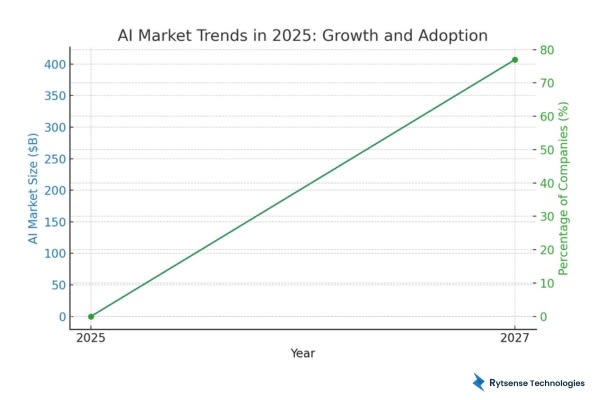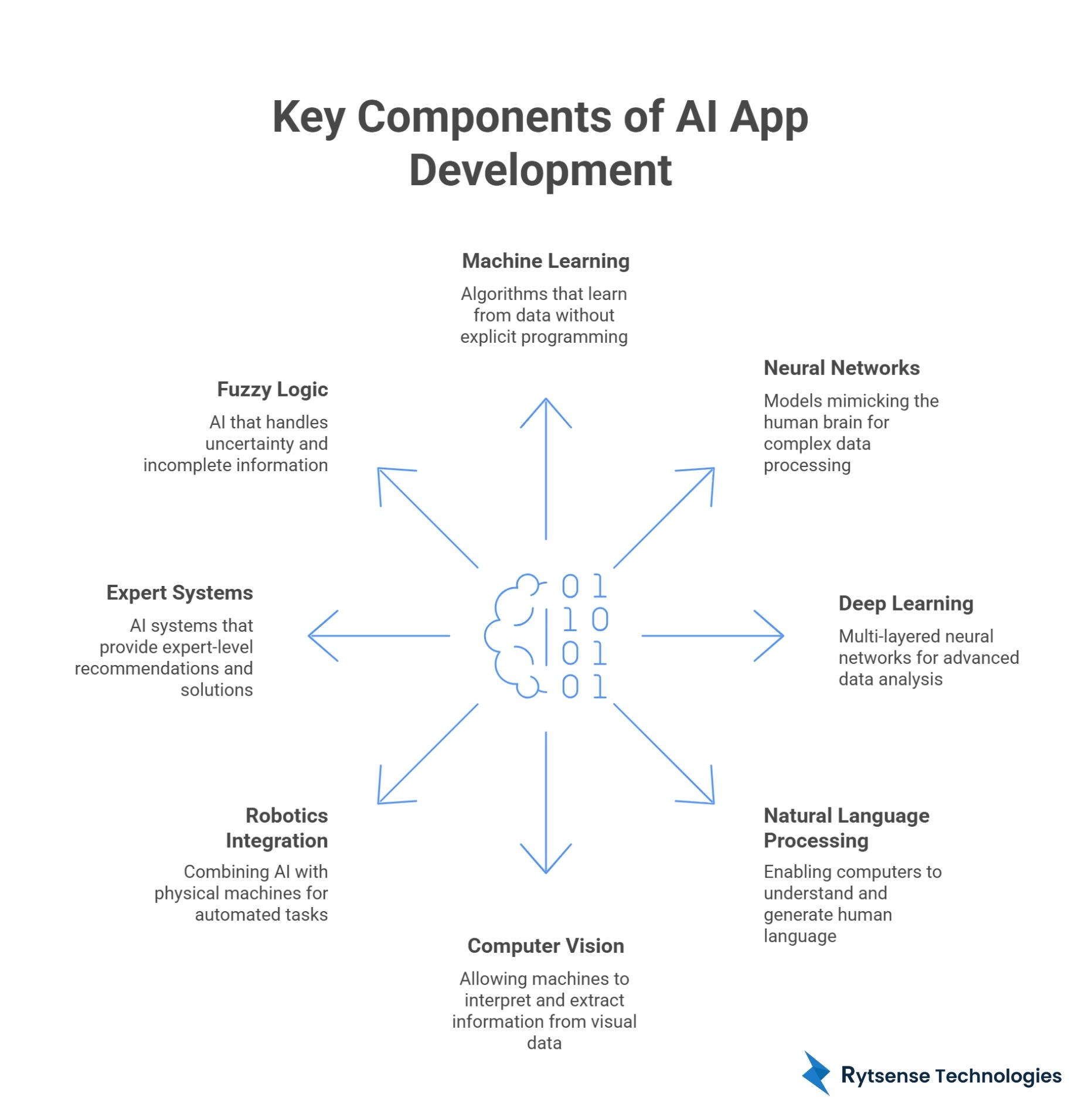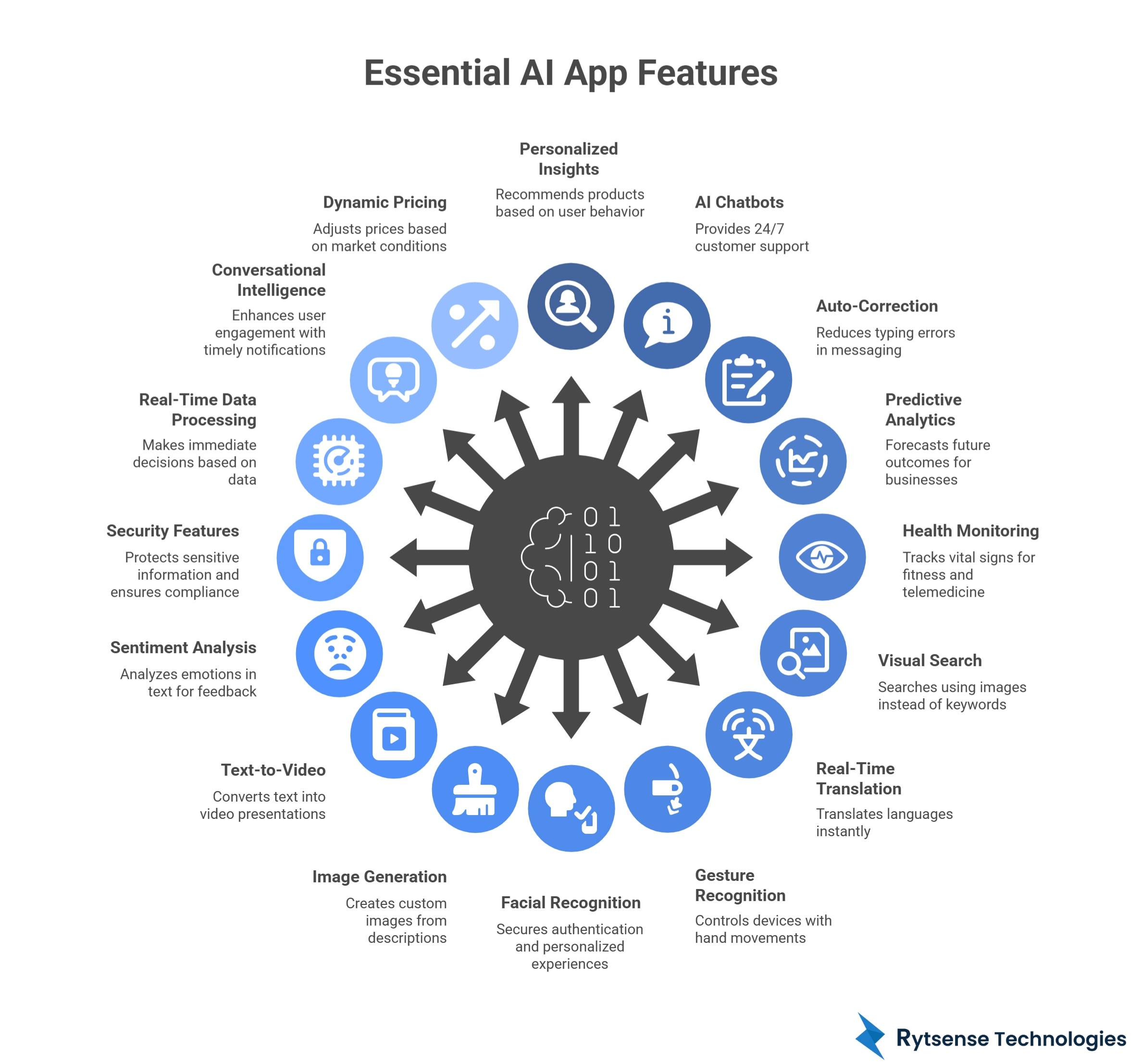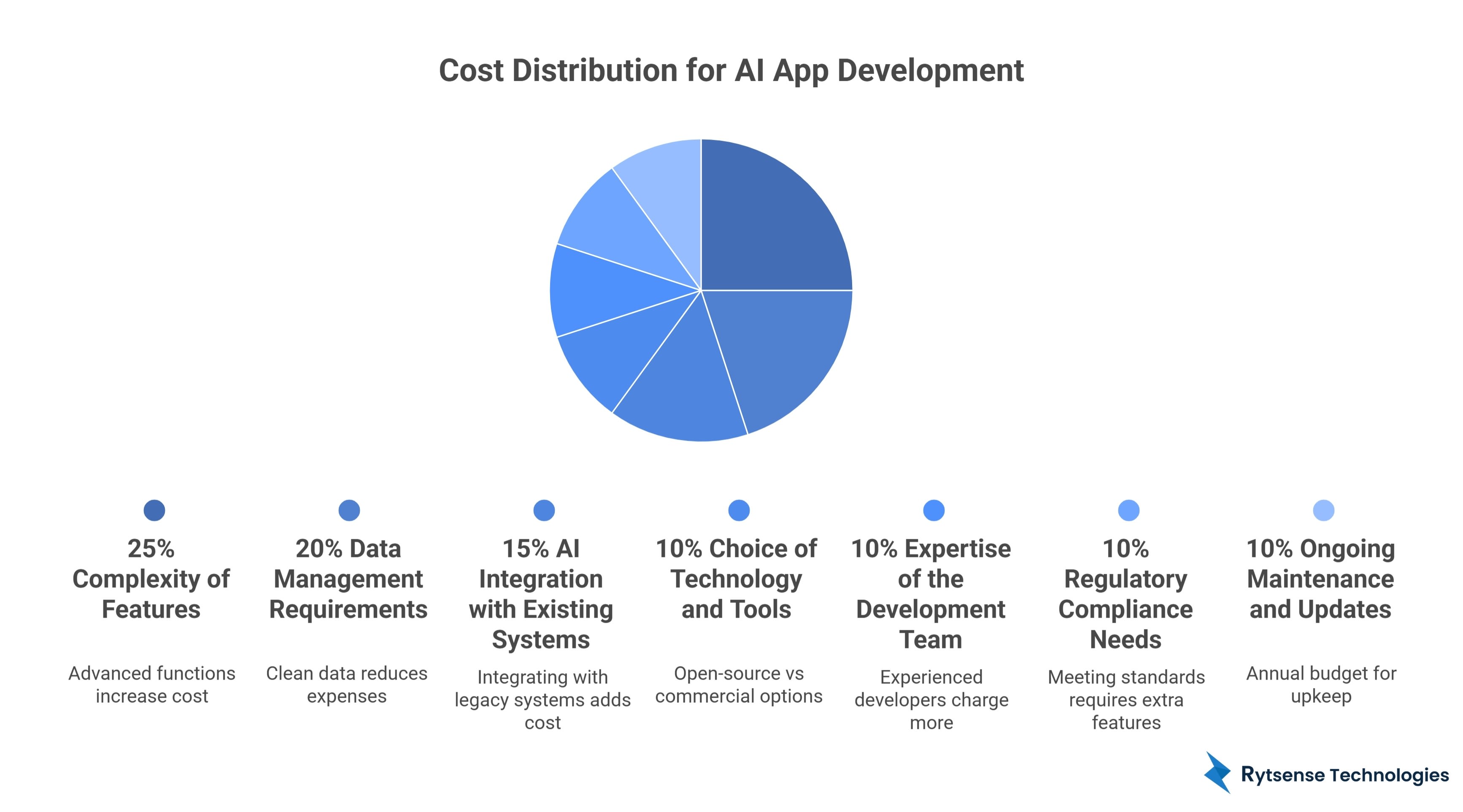Key Takeaways
Define specific, measurable business objectives before starting AI app development to ensure focused solutions that deliver ROI within 18-24 months.
AI app development costs range from $40,000 for simple apps to $500,000+ for enterprise solutions, with complexity and data requirements being primary cost drivers.
High-quality data is critical for AI success, requiring minimum 10,000 labeled examples and ongoing management to maintain model accuracy over time.
Select AI technologies that match your use case; machine learning for predictions, NLP for language processing, computer vision for image analysis, and deep learning for complex tasks.
Budget 15-20% of initial development costs annually for maintenance, model retraining, and updates to prevent performance degradation and keep pace with evolving data patterns.
How to Build an AI App for Your Business: Complete Guide
For businesses to remain competitive in 2025, it is becoming essential to understand how to build an AI application. Industry data suggests the global AI marketplace will reach $407 billion by 2027 and over 77% of companies are already using AI technology or exploring what AI technology could provide for their organization.
Enterprises that leverage an AI application for their operations report an average productivity improvement of 40% and a cost reduction of up to 30% in the first year of adoption. Knowing how to build an AI application allows organizations to automate processes and offer a more personalized experience with their customer. They may also quickly make data-driven decisions with proven confidence.

Know the Core Elements of AI Applications
Key Components in How to Build an AI App

Machine Learning (ML) for Smarter Apps
Neural Networks for Complex Problem-Solving
Deep Learning in AI Applications
Natural Language Processing (NLP) Capabilities
Computer Vision for Intelligent Analysis
Robotics Integration in Apps
Expert Systems for Decision-Making
Fuzzy Logic AI for Handling Uncertainty
Advantages of Building an AI App for Your Business
Generating Intellectual Property Through AI
Full Control Over Your Data
Greater Business Flexibility and Agility
Long-Term Cost Savings
Strengthened Security Measures
Future-Ready Business Operations
Ready to take your business to the next level with AI?
Contact us to explore custom AI solutions tailored for your business needs.
Industry-Specific Applications When You Build an AI App
Healthcare - Predictive Analytics for Better Patient Care
Transportation - Autonomous Vehicle Solutions
Real Estate - Market Analysis and Property Valuation
Retail - Personalized Shopping and Recommendations
Finance - Intelligent Budget Management
Manufacturing - Predictive Maintenance Solutions
Step-by-Step Guide on How to Build an AI App

Identify the Problem and Define Your Business Objectives
What You Can Do:
- Define the current pain points with quantifiable measures
- Identify the stakeholders and the requirements
- Create your specific, measurable KPIs for achievement
- Plan the budget and timeframe
Select the Right Use Case and AI Model
Choose a Scalable Technology Stack
| Component | Options | Best For |
|---|---|---|
| Programming Language | Python, R, Java | Python for versatility |
| ML Frameworks | TensorFlow, PyTorch, Scikit-learn | TensorFlow for production |
| Cloud Platform | AWS, Google Cloud, Azure | AWS for mature AI services |
| Database | PostgreSQL, MongoDB, Redis | PostgreSQL for structured data |
| API Framework | FastAPI, Flask, Django | FastAPI for ML model serving |
Gather and Prepare High-Quality Data
Data requirements:
- At least 10,000 labeled examples for supervised learning,
- Equitable representation in categories,
- Current data updated regularly,
- Clear documentation and versioning.
Train, Validate, and Optimize Your AI Model
Timeline for training:
- Basic models: 1-2 weeks,
- Moderate complexity models: 4-6 weeks,
- Complex deep learning models: 8-12 weeks.
Design an Intuitive and Explainable UI/UX
Integrate the AI Model with the Backend System
Conduct Rigorous Testing of the AI App
Later, testing edge cases, adversarial inputs, and performance under load is essential. Finally, ensure that the AI works correctly when looking at various demographic factors and in different contexts.
Testing Checklist:
- Functional testing of the app features
- Model accuracy and bias testing
- Performance and load testing
- Security and vulnerabilities testing
- User acceptance testing
Deploy and Maintain Your AI Application
Maintenance Requirements:
- Weekly performance
- Monthly data quality review
- Quarterly retraining of the model
- Annual architecture review
Interested in developing a custom AI app for your business?
Get a free consultation with our AI experts today!
Essential Features to Include When You Build an AI App

Personalized Insights
AI-powered chatbots and Voice Assistants
Auto-Correction and Predictive Text
Predictive Analytics
Health Monitoring
Visual Search Capabilities
Real-Time Language Translation
Gesture Recognition
Facial Recognition
Image & Sticker Generation
Text-to-Video
Sentiment Analysis AI apps
Security and Compliance Features
Real-Time Data Processing
Conversational Intelligence
Dynamic Pricing Strategies
Fraud Detection and Risk Scoring
Intelligent Search
Behavior-Based Personalization
Offline AI Capabilities
Adaptive Learning Flows
Voice Biometrics
AI-Driven Content Moderation
How Much Does It Cost to Build an AI App?
| Project | Scale | Cost Range | Timeline | Team Size |
|---|---|---|---|---|
| Simple AI App | Small | $40,000 - $80,000 | 3-4 months | 3-5 developers |
| Medium Complexity | Medium | $80,000 - $200,000 | 5-8 months | 5-8 developers |
| Enterprise Solution | Large | $200,000 - $500,000+ | 9-18 months | 8-15 developers |

Factors That Influence the Cost of Your AI App
Complexity of Features
Data Management Requirements
AI Integration with Existing Systems
Choice of Technology and Tools
Expertise of the Development Team
Regulatory Compliance Needs
Ongoing Maintenance and Updates
Testing and Quality Assurance
Not sure which AI model fits your business needs?
Talk to us about finding the perfect solution.
Exploring Monetization Models for Your AI Application
- Subscription model: Monthly or annual rates for access to AI features ($10-$500/month, depending on AI capabilities).
- Freemium model: Access to basic features for free, but paying for premium AI capabilities (2-5% of users convert).
- Pay-per-use: Charge for API calls, predictions, or data processed (ideal for B2B apps).
- Licensing: Sell your AI technology to businesses ($50,000-$500,000 a license).
- Data monetization: Sell aggregate anonymous insights to market research companies (need to take privacy advisory into consideration).
- Advertising: Free app, monetized with targeted ads with personalization via AI.
- Transaction fees: Take a percentage of the transactions your AI facilitated (common in fintech).
Emerging Trends in AI App Development
AI and IoT Convergence
Deep Learning for Enhanced Personalization
Integrating Generative AI Into Workflows
Explainable AI for Regulatory Compliance
Edge AI for Low-Latency Enterprise Solutions
Growth of Autonomous AI Agents
No-Code and Low-Code AI Platforms
Human-AI Collaboration for Better UX
Retrieval-Augmented Generation (RAG) for Accurate Real-Time Results
Quantum AI Developments
AI for ESG and Sustainability Initiatives
Want to ensure your AI app stays updated and optimized?
Reach out to our support team for continuous maintenance and monitoring.
Overcoming Common Challenges in AI App Development
Integration With Legacy Systems
Addressing Talent Concerns
Addressing Talent and Skill Gaps
Managing Implementation Costs
Setting Realistic Expectations
Ensuring Algorithmic Fairness
Scaling AI Solutions Effectively
Keeping Up With Technology Evolution
Data Management, Privacy, and Model Training Challenges
Finding Data Dilemma in Enterprise AI Projects
Solving the Cold Start Problem
Complexity and Cost of Model Training
Strategic Approaches for Enterprise AI Implementation
- Executive Sponsorship: Gaining a commitment of leadership time and dollars
- Center of Excellence: Creating an AI team to promote learning and identify best practices
- Phased Roll-Out: Initiating lower-risk pilots for successful implementation on an enterprise-wide basis
- Change Management: Transitioning users while managing fears and concerns about their jobs
- Governance Framework: Having policies in place for data consumption, model approval, and risk mitigation
How to Measure the ROI of Your AI App
Reducing Manual Efforts
Improving Accuracy and Operational Efficiency
Enhancing Customer Satisfaction and Retention
Accelerating Decision-Making
Reducing Operational Costs
Enabling Scalable Solutions
Conclusion
Learning how to build an AI app is essential to ensure a sustained competitive advantage, especially as our economy continues to become increasingly digital. Achieving that advantage will take a knowledge of AI technologies, understanding what use cases to apply them to, finding skilled teams to implement them, and following development processes and methodologies.
Start small, with clear, defined problems to tackle, look closely at the results, and scale gradually. The organizations that adopt AI app development, whether it is through a best AI development company out of the USA or by their own AI development service capabilities, will lead their industries in the near future. Follow the complete guide to know how to build an AI app.
Meet the Author

Karthikeyan
Connect on LinkedInCo-Founder, Rytsense Technologies
Karthik is the Co-Founder of Rytsense Technologies, where he leads cutting-edge projects at the intersection of Data Science and Generative AI. With nearly a decade of hands-on experience in data-driven innovation, he has helped businesses unlock value from complex data through advanced analytics, machine learning, and AI-powered solutions. Currently, his focus is on building next-generation Generative AI applications that are reshaping the way enterprises operate and scale. When not architecting AI systems, Karthik explores the evolving future of technology, where creativity meets intelligence.